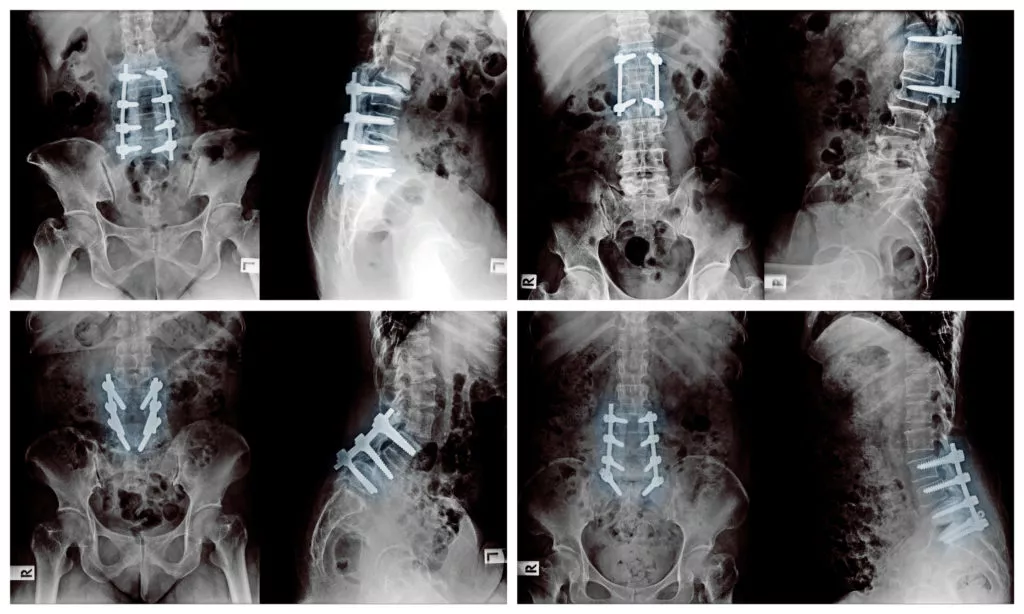
The human spinal column comprises over 30 vertebrae, most of which are separated by hard-shelled gelatinous discs. These discs act as both a flexible ligament between our vertebrae (to allow us to bend, twist, and turn) and as shock absorbers. They are tough and rubbery on the outside but softer on the inside. Spinal disc problems are aplenty among older adults and people with a history of manual labor or back injuries, and most commonly stem from herniated discs.
Unlike the name implies, however, slipped or herniated discs do not involve any physical slipping. Your discs stay in place throughout your life, but they can swell or tear. A herniated disc occurs when one of your intervertebral discs is herniated or ruptures, causing the soft interior to leak out of the rubbery exterior and compress the surrounding nerve roots which connect to your spinal cord (and, in turn, your brain). This nerve compression can be tremendously painful, and depending on the degree of the compression, it can also be permanently damaging.
However, most of the time, herniated discs are treated with rest and minimal therapy – and go away over time. More telling is the fact that not all herniated discs cause symptoms of pain. Disc degeneration and herniation are often naturally occurring and asymptomatic. While a herniated disc can cause back pain (especially when it occurs in a spine section correlating with the pain), it may not be the only cause.
Understanding the Causes of Herniated Discs
We trust our intervertebral discs to manage and minimize a lot of physical stress over the years. That takes its toll with time, and certain unavoidable biological factors (namely, the aging process) compromise the strength and durability of our discs with time. This can be limited via a healthy lifestyle, of course – by staying fit, eating well, being hydrated, and avoiding back-breaking labor and injuries – but life being what it is, everyone’s risk of developing disc-related pain increases past middle age.
As our discs weaken and dry up, they become more prone to rupturing or becoming damaged due to stress. Like the straw that broke the camel’s back, the onset of a herniated disc can be as simple as a slight turn after getting out of the shower or getting out of bed the wrong way. In other cases, herniated discs result from a back injury – such as having something fall onto your spine or landing poorly on your back from a certain height.
Regardless of whether the reason is traumatic or innocuous, herniated discs are a relatively common occurrence. Degenerative disc disease (DDD), desiccated discs, and other age-related spinal conditions can lead to both symptomatic (i.e., painful) and asymptomatic herniated discs, as can certain working conditions and injuries. Overall, herniated discs are only a concern when they become symptomatic. On their own, these ruptures and herniations heal. Even in cases where there is pain, a conservative approach is often the first line of treatment.
This includes over-the-counter painkillers and anti-inflammatory drugs (such as ibuprofen), rest and moderate movement, and, if applicable, dietary changes (obesity can exacerbate spinal conditions and make a recovery take longer). But a herniated disc can be part of something more serious. The brain communicates with the rest of the body via the spinal cord and its nerve roots. The cord is protected by a sheath within the spinal column and a series of bones. But several diseases and conditions can damage the cord and the surrounding nerve roots, causing:
- Lack of feeling.
- Tingling sensation.
- Muscle spasms in the neck.
- Pain near or in one shoulder.
- Pain radiating down one leg and buttock.
- Pain radiating down to the fingers of one arm.
- Difficulty controlling bowel movements and urination.
Any severe back pain or difficulty moving a limb requires the attention of a medical professional. Sudden loss of strength or bowel movement control requires emergency care.
How Are Herniated Discs Treated?
When a person’s back or neck pain is more severe, and imaging shows that the cause may be a herniated disc, other treatments may be necessary. A doctor and pain specialist will determine the treatment needed based on the patient’s history and pain levels, with two aims:
- To reduce the swelling and promote healing.
- To bring the pain down to a manageable level and maintain quality of life.
This can be achieved through non-opioid and opioid medication, physical therapy, corticosteroid injections, nerve blocks, other minimally invasive interventions, and in worst-case scenarios, surgery. Nerve blocks and powerful painkillers also typically become an option once the pain persists past the point where it should have healed (i.e., about three months). Surgery is usually only considered when all other options have been exhausted and the pain has become chronic.
Related Spinal Disc Problems
The spine is a complicated part of the body and an integral one too. Without it, our brain cannot communicate with the rest of the body. Thankfully, it is a well-protected body part, but there are specific points of weakness – the neck and lower back – that are more often compromised than the rest of the spine.
From whiplash to construction work, there are many physical causes of pain in the back and spine. But other conditions can cause similar pain to a herniated disc and may show related symptoms, some of which can be identified via imaging tests. These include spinal stenosis (narrowing of the spinal sheath), spinal osteoarthritis, and spondylolisthesis (a herniated vertebrae).
If you have back or neck problems, and the pain isn’t going away, you must talk to your doctor. Conservative, albeit early treatment, can go a long way towards preventing a chronic back condition. When back pain does become chronic, it can take a team of specialists to address and affect the pain – as well as a long-term pain management plan.
Take the First Step Towards Pain-Free Living Today

